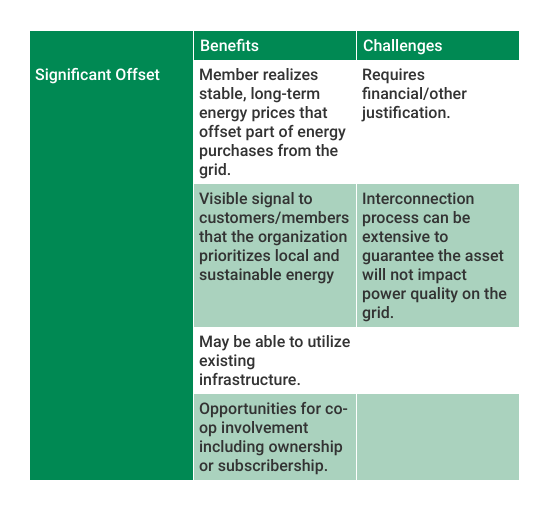A BTM project provides unique benefits to the project host. The host, through the process of project design, is able to choose the percent of their energy requirements that will be met by their project so as to meet their own objectives while also living within their own financial, resource, land, circuit, and permitting constraints. Such a project would therefore typically be interconnected behind the host revenue meter although there are special cases in which cooperatives have allowed the project to be virtually net metered to accommodate siting or resource concerns.
Because these types of projects can range in size from small demonstration projects to industrial-scale projects, the requirement for a favorable project cash flow can also be on a sliding scale.
[section separator="true"]
[section-item 6]
[row]
[column 12]
[panel panel-style="panel" color="primary" title="Case%3A%20BTM%20Significant%20Offset"]
Designed not to exceed average annual energy requirements because there is rarely a business case for exporting energy on an annual basis. Typically at a location with significant energy demands like a commercial, industrial, or institutional facility.
Example:
Honda Transmission Plant in Russells Point, OH
To help reach Honda Motor’s sustainability goals, the leadership at Honda Transmission Manufacturing of America installed two 1.7 MW wind turbines next to their facility in Russells Point, OH. Since commissioning the turbines have met or exceeded the goal of providing 10% of the plant’s energy on a yearly basis.
Template Design: tower/foundation/1-line electrical
[/panel]
[/column]
[/row]
[/section-item]
[section-item 6]
[row]
[column 12]
[panel panel-style="panel" color="primary" title="Case%3A%20BTM%20Small%20Offset"]
Designed to offset a small percentage of energy needs with on-site renewable generation.
Example:
Minnick Farm near Cosmos, MN
The Minnick family installed a 25 kW turbine behind their utility meter to lock in a low, fixed energy price when their farm's energy demands increased. Local, state, and federal financial incentives made the project economics even more favorable.
Template Design: tower/foundation/1-line electrical
[/panel]
[/column]
[/row]
[/section-item]
[/section]
[section separator="true"]
[section-item]
[row]
[column 12]
[panel panel-style="panel" color="primary" title="Case%3A%20Off-Grid"]
Off-grid projects are a special class of distributed generation project in that they are typically justified as an alternative to line extension to a specific, typically smaller, load. Examples of off-grid projects include remote cabins, telecommunications towers, or water pumps. This type of project usually includes energy storage and additional systems to balance power flow and to ensure the batteries remain healthy. If a backup generator is also included in the system design then the system management is also responsible for turning the generator on and off as needed. These systems can range from very small (less than 1kW) to large (such as for a remote mining operation), and the system design complexity and cost range accordingly.
Example:
Template Design:
tower/foundation/1-line electrical
[/panel]
[/column]
[/row]
[/section-item]
[/section]
[section]
[section-item]
[row]
[column 12]

[/column]
[/row]
[/section-item]
[/section]
[section]
[section-item]
[row]
[column 12]

[/column]
[/row]
[/section-item]
[/section]
Related Resources
[section]
[section-item]
[row]
[column 4]
[button title="Distributed%20Wind%20Toolkit" link="%2Ftopics%2Fdistributed-energy-resources%2Fwind%2F" icon="home" /]
[/column]
[column 4]
[button title="RADWIND%20Project" link="%2Fprograms-services%2Fbts%2Fradwind%2F" /]
[/column]
[column 4][/column]
[/row]
[/section-item]
[/section]
